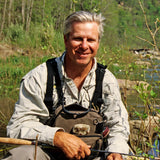Mike Smith with a speckled trout caught with the new Fish-Skull® Captain Dubiel's Pop-N-Fly™.
It’s been said that 10% of fishermen catch 90% of the fish. While the actual numbers may not be exact, this old adage rings as true today as ever. But why is it the case that some anglers seem to be successful time and time again while others are not so lucky?
Well, for starters, luck has little to do with it. Fly fishing involves a host of skills ranging from well-honed casting mechanics to sophisticated presentations, but mastery of these alone does not guarantee success. There are, in fact, a number of identifiable intangibles shared by the “fishy” 10% of anglers that truly separate them from the pack.
1. They practice the Zen of fly fishing.

Photo by Clifton Alan Broyhill.
To begin with, most of these anglers (whether knowingly or not) practice what I call the “Zen” of fly fishing. On a basic level, this means that they fully immerse themselves in the moment while on the water (as opposed to conducting business on their cell phone, for example). These anglers are able to separate their time on the water from personal and business matters. This means that they lose themselves in the process. Fly fishing, by nature, involves intense concentration and an attention to detail on multiple levels. Clearly, focus is required to execute proper casting, presentation, and mending--all vitally important elements. On a higher plane though, the Zen experience entails losing your sense of self and “becoming one” with the environment, the water, and yes—the fish. This might sound trite, but in reality it means having an innate feel for what the fish are doing—an acute awareness of their behavior at that very minute. Coupled with general fishing experience, this is an essential ingredient to success.
2. Commitment.

Flymen guide Austin Green. Photo by Morgan Kupfer.
Another character trait invariably shared by uncommonly “fishy” folks is commitment. When I see clients who fish with me once or twice a season (and that is about half the fly fishing they do for the year) struggle with casting, line control, hook sets... you fill in the blank, I remind them that they probably wouldn’t expect to break a hundred on the links if they only played golf twice a year either! While these clients may be relegated to the 90% faction, others are willing (and able) to put in their time on the water, seeing every day as an opportunity to learn something new. They approach a tough bite as simply a challenge. To these few, fly fishing is always an interrogatory pursuit—a mental exercise composed of constant questions and answers. Most anglers realize that changes in conditions, seasons, or bodies of water dictate how and what to fish, but the 10% can discern the finest of situational differences. For example, they ask: “Why did I catch a fish in this location last trip (mid-spring) and there are no fish holding there now (early summer)? What is different? Is it the water temperature, flow of the river, time of day? How about the hatch?” The list of variables can get lengthy, but the “fishy” ones are able to string them into a formula. Then, through trial and error, they continually assess the equation and adjust their tactics accordingly.
3. Patience

Flymen head honcho Martin Bawden with a striped bass.
This bring me to patience. Patience is truly a virtue, but never more so than when fishing. The best fly fishers recognize its value on so many levels. For starters, there are a lot of meticulous activities involved in fly fishing (think about tying on a #22 midge) that can test anyone’s patience. But it also pays to be patient when dealing with such every day occurrences as tangled lines (or encountering other technical issues), which can be made exponentially worse by flailing the rod about pell-mell. Being in a hurry and fly fishing simply don’t mesh. Fly fishing is more about efficiency and repetition than about how fast you can cover water or how many fish you catch. If you can relate to the satisfaction garnered from working a single trout for an hour and changing flies multiple times before achieving your goal, then you may be one of the select.
4. Ability to read water.

Canadian Flymen guide Dwayne Cromarty with a pike caught on a Fish-Skull® Chocklett's Articulated Big Game Shank™ fly.
Finally, these “fishy” anglers have one other common denominator—a sophisticated proficiency at reading water. Briefly, there are three main factors pertaining to fish habitat that determine where fish will hold –water quality, safety, and, lastly, food availability. As an example, consider that in the summer months, on many Eastern freestone streams trout will predictably search out cool, well-oxygenated areas such as rapids that provide higher levels of dissolved oxygen or spring heads with lower temperatures as a survival mechanism. Rapids also have riffles which allow for protection from aerial predators as well as providing regular hatches. Boulders and ledges in these areas will also offer protection, current breaks, and ambush points for feeding. Though fish will venture from these safe zones, they are rarely far from the first two essentials. Locating these areas and adding to it the knowledge of what the fish are feeding on leads directly to success.
Quick review.
So adopt these intangible characteristics (the Zen of fishing, commitment, patience, and reading water), add to them a higher than average level of optimism, and you are likely to find yourself in that special tier of anglers who are catching most of the fish!
About Mike Smith:
 Mike is a fly designer and lead smallmouth guru at Flymen Fishing Co., as well as the owner and operator of New River Fly Fishing. He's written five fly fishing books, known as the Angler’s Guide Series. His signature flies include the Skull Daddy Crayfish, Foxy Shrimp, Forage Fly, Saltwater Forage Fly, River Creature, Salt Creature, and Egg Sucking Flash Minnow.
Mike is a fly designer and lead smallmouth guru at Flymen Fishing Co., as well as the owner and operator of New River Fly Fishing. He's written five fly fishing books, known as the Angler’s Guide Series. His signature flies include the Skull Daddy Crayfish, Foxy Shrimp, Forage Fly, Saltwater Forage Fly, River Creature, Salt Creature, and Egg Sucking Flash Minnow.




